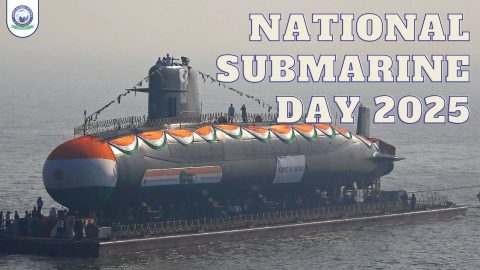Every year on April 11, National Submarine Day is celebrated. This day is especially dedicated to all the naval personnel, scientists, and engineers who have contributed to the development, operation, and advancement of submarines. Let’s explore what a submarine is, its history, its role, and how it has evolved over time.
What is a Submarine?
A submarine is a type of vessel that can operate beneath the surface of water. It is specifically designed for defense, surveillance, and attack missions. A submarine can float on the surface and dive underwater as required. Its structure and technical design make it incredibly powerful, stealthy, and capable of operating in secrecy.
- Key Points:
- Underwater Operations: Submarines can travel below the water’s surface.
- Stealth Attacks: They can strike enemies without being detected.
- Long-Term Missions: Modern submarines can stay submerged for several months.
What is the Role of Submarines?
In warfare, submarines act as invisible warriors. They can secretly infiltrate enemy territories, gather intelligence, and launch powerful attacks during combat. Besides this, submarines are also used for coastal defense, maintaining nuclear power balance, ocean surveillance, and even in disaster relief operations.
- Key Points:
- Surveillance and Intelligence: Monitoring enemy activities covertly.
- Torpedo/Missile Strikes: Targeting enemies underwater or on the surface.
- Nuclear Strength: Capability for strategic nuclear attacks.
- Coastal Security: Protecting maritime borders.
- Scientific/Relief Missions: Underwater search and rescue operations.
History of Submarines
The history of submarines dates back to the 17th century. The first submarine was built in 1620 by Dutch scientist Cornelius Drebbel. Later, in 1775, the United States used a submarine called “Turtle” during warfare. However, the era of modern military submarines began on April 11, 1900, when the U.S. Navy inducted the USS Holland.
- Key Points:
- 1620: Cornelius Drebbel’s first submarine.
- 1775: The “Turtle” used during the American Revolutionary War.
- 1900: USS Holland, the first modern military submarine.
- April 11: Celebrated as National Submarine Day for this reason.
Why is National Submarine Day Celebrated?
Every year on April 11, National Submarine Day is observed in the U.S. and many other countries. This day honors the brave naval personnel, scientists, and engineers who have played a vital role in building, operating, and advancing submarine missions.
- Key Points:
- Anniversary of USS Holland: First inducted into the U.S. Navy on April 11, 1900.
- Military and Scientific Contribution: Recognizing efforts in submarine technology.
- Patriotism and Inspiration: Inspires youth toward national service.
Features of Modern Submarines
Today’s submarines are equipped with cutting-edge technology. They are powered by nuclear reactors, fitted with advanced sensors, missile systems, and air recycling units. These submarines operate silently and can effectively avoid enemy detection.
- Key Points:
- Nuclear Power: Can operate underwater for months without surfacing.
- Silent Operation: Conduct missions without making detectable noise.
- Sensors/Sonar Systems: Highly advanced target detection.
- Multiple Weapon Systems: Equipped with torpedoes, cruise, and ballistic missiles.
Types of Submarines
Submarines are classified based on their design, function, and mode of operation. Each type serves a unique purpose and comes with specific features.
- Major Types:
- Diesel-Electric Submarine: Traditional tech, cost-effective, limited underwater time.
- Nuclear Submarine: Powered by nuclear reactors, long-duration missions.
- Attack Submarine (SSN): Fast and deadly, used to destroy enemy ships.
- Ballistic Missile Submarine (SSBN): Carries nuclear missiles for strategic attacks.
- Cruise Missile Submarine (SSGN): Equipped with cruise missiles for surface strikes.
India and Submarine Power
India has made significant progress in building and operating submarines. The country is now developing indigenous nuclear submarines and is establishing itself as a powerful submarine force globally.
- Key Indian Submarines:
- INS Arihant: India’s first indigenously built nuclear submarine (SSBN).
- INS Kalvari: Advanced diesel-electric submarine of the Scorpene class.
- INS Chakra: A nuclear submarine leased from Russia.
- INS Vagir / Karanj: New-generation Scorpene-class submarines.
Scientific and Civilian Applications
Submarines are not limited to military use. They are also used in marine research, exploration, rescue operations, and studying underwater natural resources.
- Areas of Use:
- Deep Sea Research
- Marine Biology Studies
- Oil and Gas Exploration
- Underwater Disaster Search and Rescue
India to Build New Nuclear Submarine Base in Andhra Pradesh
India is planning to set up a new naval base on the coast of Andhra Pradesh in the coming year. This base will be specifically dedicated to nuclear submarines and other warships. The decision comes in light of increasing Chinese naval activity in the Indian Ocean, aiming to strengthen India’s maritime security and strategic capabilities.
New Base to Be Established in Rambilli
The new naval base will be constructed near the village of Rambilli, located approximately 50 kilometers south of the Eastern Naval Command headquarters in Visakhapatnam. The facility will include underground tunnels and secure pens to protect nuclear submarines from surveillance satellites. These submarines will then be able to stealthily enter strategic waters like the Bay of Bengal and the Malacca Strait.
Progress Under ‘Project Varsha’
The construction of this base is part of ‘Project Varsha’. The first phase of the project is nearly complete and is expected to become operational by 2026. Subsequent phases will see gradual development and expansion of the base, much like the ongoing work at the Karwar base in Karnataka under ‘Project Seabird’.
Expansion of Karwar Naval Base
India’s Karwar naval base, located on the western coast, is also undergoing rapid upgrades. Under Phase-IIA of Project Seabird, the base will be equipped to host up to 32 warships. This expansion marks a significant step in enhancing the Indian Navy’s strength and countering China’s growing presence in the Indian Ocean region.
INS Aridhaman: India’s New Nuclear Submarine
India is also planning to induct its third nuclear-powered submarine, INS Aridhaman, into the Navy later this year. The submarine will have a displacement capacity of 7,000 tonnes and will be equipped with K-4 ballistic missiles capable of striking targets up to 3,500 kilometers away. This addition will further reinforce the underwater leg of India’s nuclear triad.
Through these strategic initiatives, India is steadily boosting its naval capabilities. With the establishment of new bases and induction of advanced nuclear submarines, India is moving swiftly to play a vital role in maintaining security and strategic balance in the Indian Ocean region.
Conclusion
Submarines are a marvel of modern defense and technology. They remind us that national security isn’t just about land and sky, but also the depths of the ocean. National Submarine Day is not just a celebration—it is a tribute to the unsung heroes who defend the nation from beneath the waves.





